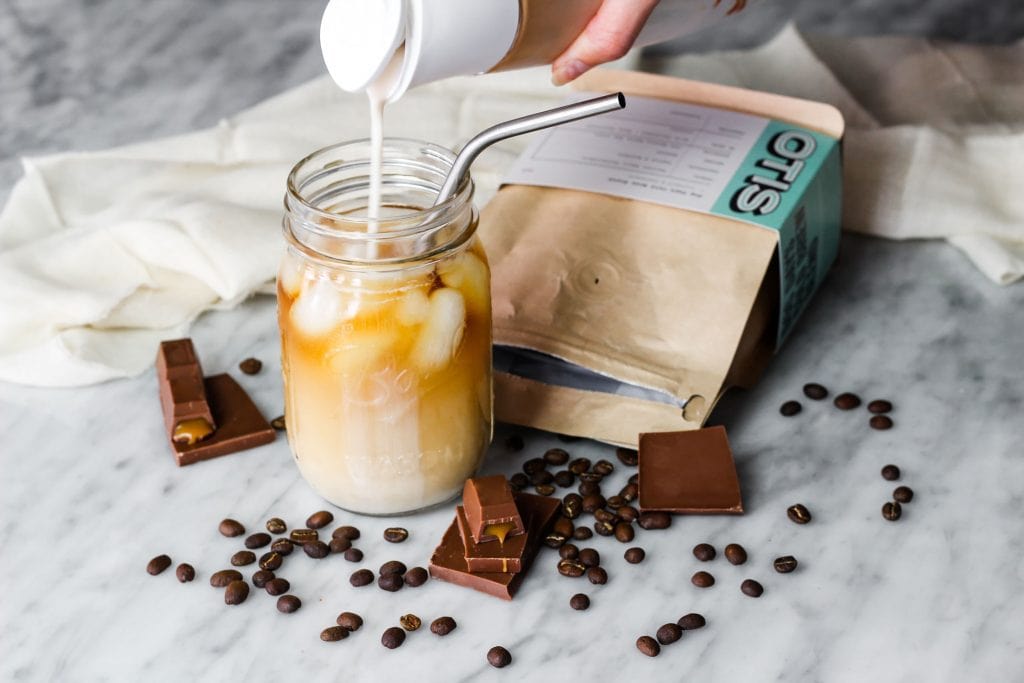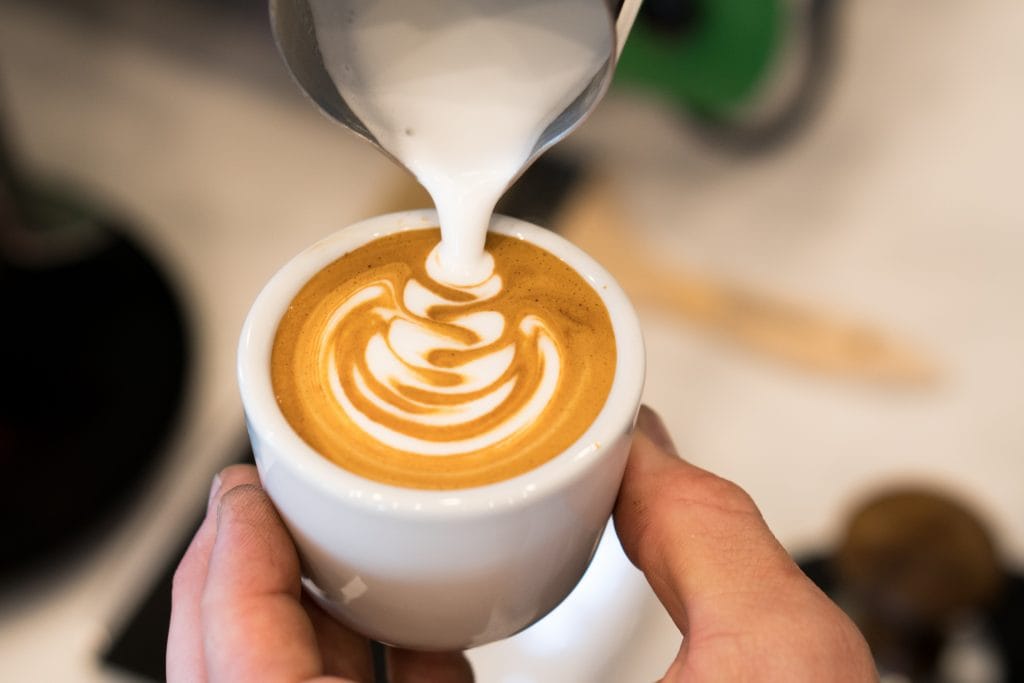Are you wondering if you can froth creamer? The answer is simple: yes, you can. And you have many options to get frothy coffee at home.
I love taking a sip of frothy coffee because it feels like a tender caress. But paying a daily visit to my favorite coffee shop isn’t cheap. Luckily for you and me, we don’t need to drink watery coffee to save our pennies.
Why use coffee creamers
Coffee creamers can be homemade or store-bought. Many prefer non-dairy alternatives for health-related issues. Some creamers are lactose-free, others are low in sugars. In contrast, many come in a variety of flavors and are pretty sweet.

Photo by Rozhita Rasouli on Unsplash
One of the reasons for loving creamers is their generous offer of flavors. Usually, you can find creamers with a lower calorie content and lower fat content than milk. Some even add a more intense flavor.
Many coffee enthusiasts prefer coffee creamer instead of milk because it’s a healthier option and can have a lot of flavors. In terms of health, many prefer plant-based alternatives like almond, oat, and soy milk.
What options are available for frothy coffee?
There are quite a few ways to make frothy coffee. These include both artificial creamers, animal milk, and plant-based milk, among others.

Artificial creamers vs homemade creamers
You can find artificial creamers in most supermarkets. Usually, they include sweet flavors that match dark roasts and are very popular.
However, artificial creamers are not the only option. Homemade versions are made by boiling milk, then adding cream, half-and-half, and other ingredients.
Milk
The most traditional option for any barista or coffee enthusiast is milk. Depending on fat content, milk can add a variable degree of body and mouthfeel to a cup of coffee. However, some people feel bloated or sick after drinking whole milk. As you may know, it’s awful for people having lactose intolerance, which is one of the reasons for using plant-based milk.
Plant-based milk
Soy milk was the first plant-based milk that I tried, and back in the day, it was sweet and affordable. Now, like most types of plant-based milk, you can find unsweetened alternatives.
If you prefer a neutral taste, go for soy. The unsweetened type offers body and a mild flavor, unlike almond milk that can overpower your coffee. Soy milk is usually the most affordable of plant-based milk types, and it has a lot of proteins and is low in unhealthy fats.
Oat milk is my second favorite when making a cappuccino or any drink without overpowering my coffee taste. Additionally, it’s a healthy option with tons of unsaturated fats. Yet, my favorite brands can be pricey, so I take them now and then.
A cappuccino with frothy almond milk and dusted with cinnamon powder is one of my favorites but my everyday go-to. In my opinion, almond milk can overpower the coffee taste, but it’s an excellent and healthy option, considering all the benefits of eating almonds.
Half and half
If you want some extra energy, half-and-half is a good alternative. Breve coffee is a recent addition to the café menu, mixing espresso with half and half.
As you may know, half-and-half is rich in unhealthy fats, and it takes a lot of work to burn those calories. Still, it makes for a yummy treat now and then.
When it comes to frothing, the fatter nature of half-and-half makes it less frothy than milk. For this reason, frothy coffee with half-and-half has a thinner layer of foam on top in comparison with creamers and milk. It’s the perfect addition to having a thicker, creamier cup of coffee.
MCT Oil
Keto diet enthusiasts are all over the place with MCT oil. Initially a dietary supplement, many are using it as a coffee creamer.
In traditional flavors like vanilla and chocolate, MCT oils are a good match for coffee drinkers with a weak spot for these flavors.
Arguably, it’s healthier than milk and other creamers. Some authors claim that it helps to reduce weight, but scientific research hasn’t provided enough evidence to support this claim.
Collagen Creamer
Collagen is a well-known, healthy source of protein. You can find it easily as a supplement and as a compound in many ingredients like unflavoured gelatin.
Now it’s increasingly common to find collagen creamers since many prefer to mix with their coffee. It’s convenient, and some products are soluble enough to make an enjoyable drink.
Milk frothers 101
Microfoam is the name for that nice frothy layer on top of our coffee. We are used to having it with our cappuccinos when talented baristas serve us in our favorite café. Still, we can have quite a range of milk frothers, some specifically made for that. Others are more improvised but still useful.
Types of milk frother
- Electric whisk
- Electric milk frothers
- Espresso machine wands
- Hand-pressed milk frothers
- French press
- Blender
Reasons to use a milk frother:
1. The milk frother breaks up the fat in the cream, which makes it slightly easier to digest
2. You can use skimmed milk to make a latte. Microfoam is more stable in low-fat dairy, so you’ll get a rich body without the fat.
3. It’s cheaper than paying for frothy coffee at Starbucks
Uses for a milk frother:
- Coffee drinks with milk and non-dairy alternatives
- Hot chocolate
- Dalgona coffee
- Matcha and chai lattes
- Whip up some egg whites for French toast or souffle (this is handy when your whisker is broken)
How to froth creamer at home
Depending on the milk frother, the procedure is slightly different.
Frothing coffee creamer with an electric whisk
- If you’re using a soluble powdered creamer add it to your cup of coffee. Avoid overfilling your mug, because it can easily turn into a mess.
- If you’re using a liquid creamer, you can froth it separately, before adding it to your coffee.
- Immerse the milk frother. If you can get it near to the bottom, it will be better. Avoid frothing with the whisk too close to the surface.
- Start frothing and keep it until you notice that the creamer increases its volume.
Frothing coffee creamer with an electric milk frother
- Pour the cold liquid creamer into the milk frother.
- Turn on the frother, pick the desired temperature and start. Stop frothing when the creamer increases its volume.
- Mix and enjoy your frothy coffee!
Frothing coffee creamer with an espresso machine
- Pour cold liquid creamer into a small pitcher. If you’re using a powdered alternative, dissolve in water before starting.
- Tilt the pitcher slightly and insert the frothing wand below the surface.
- Turn the steam wand on and let the air in for a couple of seconds.
- Let the wand sink almost all the way in. Keep frothing until your creamer grows at least 1/2 inch and it’s warm.
- Serve gently, letting the microform pour on top.
Frothing coffee creamer with a hand-pressed milk frother or a French press
- Heat the cold liquid creamer in a microwave or a small pot.
- Pour the warm creamer into the milk frother. Press until you get a thin layer of foam on top. I usually aim for 1/2 inch.
- Enjoy your frothy coffee!
Frothing coffee creamer with a blender
- Mix your coffee and creamer as hot as possible.
- Pour into your blender. Start your blender at minimum speed and increase power slowly. Froth for 5 to 10 seconds, or until you get a nice layer of foam on top.
- Serve and enjoy!
How do I know when I have the perfect foam?
The perfect foam has no bubbles or holes. It looks dense and light. However, try not to froth excessively, or the foam will collapse or fill your entire mug.
It happened to me when I started frothing all the time that I frothed so much that I ended with excessive foam and less liquid than I wanted.
Credits
The featured image for this blog post is based on the original work of Charlotte May on Pexels.


